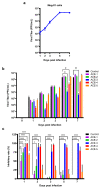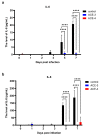Antrodia cinnamomea Suppress Dengue Virus Infection through Enhancing the Secretion of Interferon-Alpha
- PMID: 36235496
- PMCID: PMC9573221
- DOI: 10.3390/plants11192631
Antrodia cinnamomea Suppress Dengue Virus Infection through Enhancing the Secretion of Interferon-Alpha
Abstract
Dengue caused by dengue virus (DENV) is a mosquito-borne disease. Dengue exhibits a wide range of symptoms, ranging from asymptomatic to flu-like illness, and a few symptomatic cases may develop into severe dengue, leading to death. However, there are no effective and safe therapeutics for DENV infections. We have previously reported that cytokine expression, especially inflammatory cytokines, was altered in patients with different severities of dengue. Antrodia cinnamomea (A. cinnamomea) is a precious and endemic medical mushroom in Taiwan. It contains unique chemical components and exhibits biological activities, including suppressing effects on inflammation and viral infection-related diseases. According to previous studies, megakaryocytes can support DENV infection, and the number of megakaryocytes is positively correlated with the viral load in the serum of acute dengue patients. In the study, we investigated the anti-DENV effects of two ethanolic extracts (ACEs 1-2) and three isolated compounds (ACEs 3-5) from A. cinnamomea on DENV infection in Meg-01 cells. Our results not only demonstrated that ACE-3 and ACE-4 significantly suppressed DENV infection, but also reduced interleukin (IL)-6 and IL-8 levels. Moreover, the level of the antiviral cytokine interferon (IFN)-α was also increased by ACE-3 and ACE-4 in Meg-01 cells after DENV infection. Here, we provide new insights into the potential use of A. cinnamomea extracts as therapeutic agents against DENV infection. However, the detailed mechanisms underlying these processes require further investigation.
Keywords: Antrodia cinnamomea; dengue virus; inflammatory cytokines; interferon-alpha; megakaryocytes.
Conflict of interest statement
The authors have declared that no competing interests exist.
Figures





Similar articles
-
Antiviral Effects of Clinically-Relevant Interferon-α and Ribavirin Regimens against Dengue Virus in the Hollow Fiber Infection Model (HFIM).Viruses. 2018 Jun 9;10(6):317. doi: 10.3390/v10060317. Viruses. 2018. PMID: 29890736 Free PMC article.
-
Dengue Virus M Protein Promotes NLRP3 Inflammasome Activation To Induce Vascular Leakage in Mice.J Virol. 2019 Oct 15;93(21):e00996-19. doi: 10.1128/JVI.00996-19. Print 2019 Nov 1. J Virol. 2019. PMID: 31413130 Free PMC article.
-
Dengue virus (DENV) antibody-dependent enhancement of infection upregulates the production of anti-inflammatory cytokines, but suppresses anti-DENV free radical and pro-inflammatory cytokine production, in THP-1 cells.J Gen Virol. 2007 Feb;88(Pt 2):365-375. doi: 10.1099/vir.0.82537-0. J Gen Virol. 2007. PMID: 17251552
-
Antrodia cinnamomea-An updated minireview of its bioactive components and biological activity.J Food Biochem. 2019 Aug;43(8):e12936. doi: 10.1111/jfbc.12936. Epub 2019 Jun 4. J Food Biochem. 2019. PMID: 31368557 Review.
-
An emerging role for the anti-inflammatory cytokine interleukin-10 in dengue virus infection.J Biomed Sci. 2013 Jun 25;20(1):40. doi: 10.1186/1423-0127-20-40. J Biomed Sci. 2013. PMID: 23800014 Free PMC article. Review.
Cited by
-
A review on the cultivation, bioactive compounds, health-promoting factors and clinical trials of medicinal mushrooms Taiwanofungus camphoratus, Inonotus obliquus and Tropicoporus linteus.Fungal Biol Biotechnol. 2024 Jul 10;11(1):7. doi: 10.1186/s40694-024-00176-3. Fungal Biol Biotechnol. 2024. PMID: 38987829 Free PMC article. Review.
-
The crucial regulatory role of type I interferon in inflammatory diseases.Cell Biosci. 2023 Dec 20;13(1):230. doi: 10.1186/s13578-023-01188-z. Cell Biosci. 2023. PMID: 38124132 Free PMC article. Review.
References
-
- Yung C.-F., Lee K.-S., Thein T.-L., Tan L.-K., Gan V.C., Wong J.G., Lye D.C., Ng L.-C., Leo Y.-S. Dengue serotype-specific differences in clinical manifestation, laboratory parameters and risk of severe disease in adults, Singapore. Am. J. Trop. Med. Hyg. 2015;92:999–1005. doi: 10.4269/ajtmh.14-0628. - DOI - PMC - PubMed
Grants and funding
LinkOut - more resources
Full Text Sources
Miscellaneous

